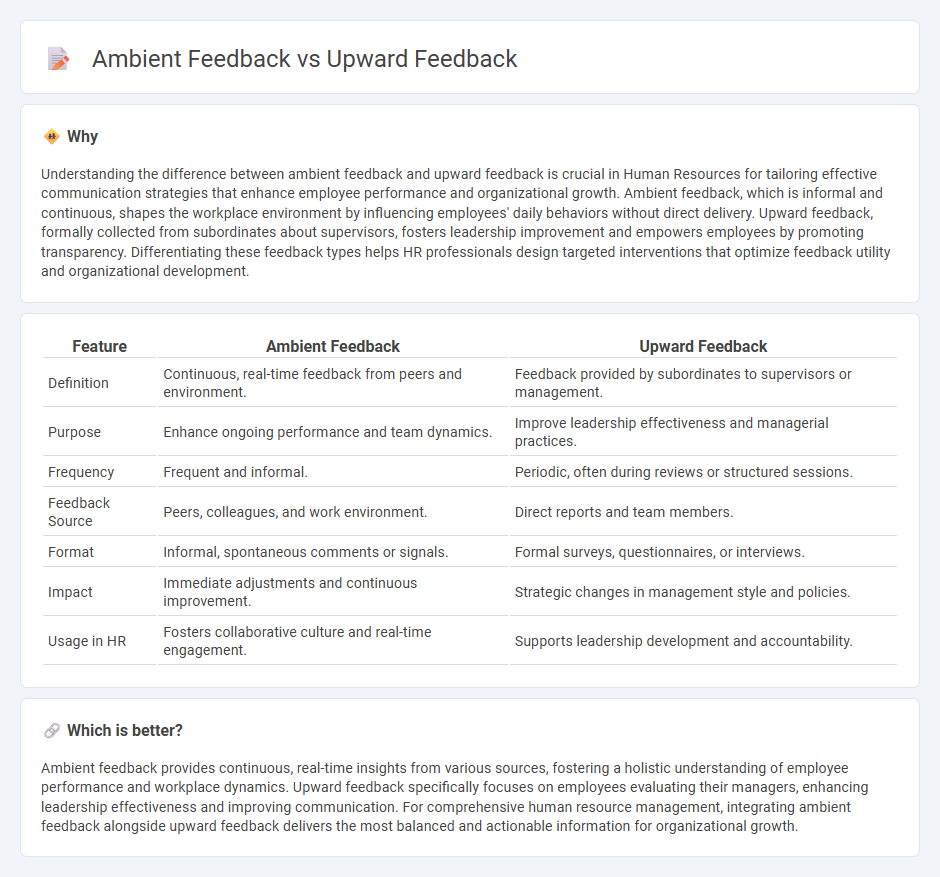
Ambient feedback captures continuous, real-time insights from various sources within the workplace, enhancing team dynamics and personal development more organically. Upward feedback involves employees providing performance evaluations and suggestions directly to their supervisors, promoting transparency and leadership growth. Explore the distinct benefits and applications of ambient versus upward feedback to improve your organization's feedback culture.
Why it is important
Understanding the difference between ambient feedback and upward feedback is crucial in Human Resources for tailoring effective communication strategies that enhance employee performance and organizational growth. Ambient feedback, which is informal and continuous, shapes the workplace environment by influencing employees' daily behaviors without direct delivery. Upward feedback, formally collected from subordinates about supervisors, fosters leadership improvement and empowers employees by promoting transparency. Differentiating these feedback types helps HR professionals design targeted interventions that optimize feedback utility and organizational development.
Comparison Table
| Feature | Ambient Feedback | Upward Feedback |
|---|---|---|
| Definition | Continuous, real-time feedback from peers and environment. | Feedback provided by subordinates to supervisors or management. |
| Purpose | Enhance ongoing performance and team dynamics. | Improve leadership effectiveness and managerial practices. |
| Frequency | Frequent and informal. | Periodic, often during reviews or structured sessions. |
| Feedback Source | Peers, colleagues, and work environment. | Direct reports and team members. |
| Format | Informal, spontaneous comments or signals. | Formal surveys, questionnaires, or interviews. |
| Impact | Immediate adjustments and continuous improvement. | Strategic changes in management style and policies. |
| Usage in HR | Fosters collaborative culture and real-time engagement. | Supports leadership development and accountability. |
Which is better?
Ambient feedback provides continuous, real-time insights from various sources, fostering a holistic understanding of employee performance and workplace dynamics. Upward feedback specifically focuses on employees evaluating their managers, enhancing leadership effectiveness and improving communication. For comprehensive human resource management, integrating ambient feedback alongside upward feedback delivers the most balanced and actionable information for organizational growth.
Connection
Ambient feedback provides continuous, real-time insights into employee performance and workplace dynamics, creating a foundation for open communication. Upward feedback, which involves employees evaluating managers and organizational practices, thrives in an environment supported by ambient feedback systems. Together, they enhance transparency, foster trust, and promote a culture of continuous improvement within human resources management.
Key Terms
Performance Appraisal
Upward feedback involves subordinates providing performance evaluations to their supervisors, enhancing leadership development and improving managerial effectiveness. Ambient feedback, by contrast, gathers input from multiple sources in the employee's environment, offering a holistic view of performance within the organizational context. Explore the impact of these feedback mechanisms on performance appraisals to optimize talent management strategies.
Organizational Climate
Upward feedback involves employees providing input about their managers, enhancing transparency and trust within the organizational climate. Ambient feedback encompasses ongoing, informal observations from peers that shape everyday interactions and overall workplace culture. Explore how these feedback types transform organizational climate and foster a thriving work environment.
Communication Channels
Upward feedback utilizes formal communication channels where employees provide structured input to supervisors, enhancing clarity and accountability. Ambient feedback occurs through informal, often real-time channels like peer interactions or digital platforms, fostering continuous and spontaneous communication. Explore further to understand how these feedback types optimize organizational communication strategies.
Source and External Links
Upward Feedback: Definition, Best Practices, Examples & How to ... - This webpage provides examples and best practices for giving upward feedback, focusing on areas such as workload and communication.
A brief guide to upward feedback (and why frontline organizations ... - This blog highlights the importance of upward feedback in improving employee experience and fostering a two-way communication culture within organizations.
50+ Upward Feedback Examples to Foster Leadership Growth - Deel - This article offers extensive examples of both positive and constructive upward feedback, emphasizing the importance of specific and objective feedback.
 dowidth.com
dowidth.com